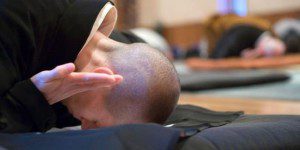 In my last post I addressed the issue of why we’ve chosen to place “Guidelines for Studying the Way” at the front of our study work here in Portland, ME, and on the Vine of Obstacles: Online Support for Zen Training.
In my last post I addressed the issue of why we’ve chosen to place “Guidelines for Studying the Way” at the front of our study work here in Portland, ME, and on the Vine of Obstacles: Online Support for Zen Training.
In this post, I’ll take up the issue of why we emphasize study at all. After all, didn’t Bodhidharma say that Zen is
A special transmission outside the scriptures
No dependence upon words and letters;
Direct pointing to the human heart
Seeing one’s nature and attaining Buddhahood.
Yeah, but….
A bit of background first.
Katagiri Roshi emphasized that the training of a Zen monk involved three aspects – zazen, study, and work. For the last aspect, work, for householders or ordained folks not living in a monastery (so 99%+ of all Zen practitioners), I prefer “engagement” due to it’s broader range of meanings. This is the aspect of making the Zen heart alive in the world by fluffing our zafu at the end of zazen, caring for our shoes, our relationships, and our world as we would for our own eyeballs.
At the same time, zazen has been the cornerstone of the Zen/Ch’an way going back to the Sung Dynasty in China where the monks sat four blocks of sitting daily.
Dogen gets much credit for his emphasis on bringing a zazen-only emphasis to Japan. Indeed, he seems to have been of a less syncretic bent than many of his contemporaries (at least in his regard for Taoism, Confucianism, and the more scholarly and esoteric Buddhist schools) including his first teacher, Myoan Eisai, who brought Rinzai Zen and green tea to Japan, and the monk who aced Dogen out of a really big important monastery (Tofukuji), Enni Bennen, who brought another Rinzai lineage and udon noodles to Japan.
Personally, as I have a great fondness for both green tea and udon, I find the syncretic camp quite tempting at the moment.
The remaining aspect of our work, following Katagiri Roshi, is study. And, wow, btw, was Katagiri Roshi a student. OMG. When I served as his attendant, I saw his life close up – zazen and study were about it. For engagement/work, he did meet with people, go to Zen Center meetings, hang out with his family, and laugh himself silly with “Gilligan’s Island” and the “Cosby Show.” Really.
This wasn’t true only for Katagiri Roshi – the study part, that is. All of the great Soto monks of the last couple hundred years (e.g., Nishiari Bokusan, Oka Sotan, Kishizawa Ian, Hashimoto Eko, Swaki Kodo), were also great scholars. Victor Hogen Sori reports the same for the Rinzai side of the family.
Anyway, even the zazen-only guy (back to Dogen) who didn’t bring back anything useful like green tea or udon, said, “There are two ways to penetrate body and mind: study with a teacher to hear the teaching, and devotedly sitting zazen.”
Studying with a teacher includes listening to dharma talks, embodying the liturgy, studying the old Zen texts and sutras together, and even taking up a koan (and if you think Dogen Zen is non koan Zen, I respectfully disagree and have a blog post in draft on just this point so stay tuned).
Dharma study has the great possibility of broadening our limited horizons and challenging our sacred cows. It is an antidote to harmful doubt. It’s often said that enlightenment is an accident and people who sit zazen or accident prone. I’d go one step further and say that people who sit and study are accidents waiting to happen.
Just sitting without study (or engagement), leads to endlessly rehearsing our old views, and nurturing those sacred cows until they’re rather bloated and stinky.
Now everything has a shadow, of course. Study can lead us to thinking that we understand the buddhadharma when we don’t – or just have it swirling in our big heads and not embodying it. That’s why study with a teacher, within the context of a community of practitioners, is a vital aspect of study.
Coming soon: “Dogen and Koans: The Smoking Gun”











